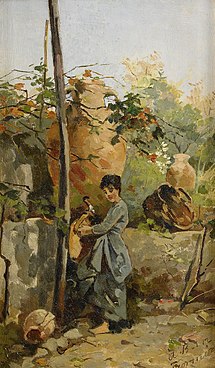Agnes Börjesson
This article includes a list of general references, but it lacks sufficient corresponding inline citations. (December 2018) |

Agnes Fredrika Börjesson, sometimes called Agneta (1 May 1827, Uppsala – 26 January 1900, Alassio, Italy), was a Swedish painter who specialized in genre and historical scenes.
Biography


Her father, Johan Börjesson, was a pastor and playwright. Her mother was a member of the noble Fock family. In 1849, she became one of the first four women admitted to the Royal Swedish Academy of Fine Arts and, from 1852 to 1853, studied with Constantin Hansen, who had recently spent a decade working in Italy.
From 1854 to 1856, she studied with the portrait and history painter,
She settled in Rome, and for a time lived with her friend, the painter Sofie Ribbing. Eventually she decided to stay in Italy, although she continued to send her works to Sweden, and, until 1880, participated in exhibitions at the Royal Academy, of which she became a member in 1872. She also had a showing at the 1873 Vienna World's Fair.
Many of her paintings were created en
Her works may be seen at the
References
- ^ "Nationalmuseum - Agnes Börjesson". emp-web-84.zetcom.ch. Archived from the original on 2020-11-17. Retrieved 2021-08-12.
Sources
- Carin Österberg, et al., Svenska kvinnor: föregångare, nyskapare. Lund: Signum 1990 ISBN 91-87896-03-6
- Svenskt konstnärslexikon Part I, pg. 264, Allhems Förlag, Malmö
- Flensburg, Birgitta. Agneta Fredrika (Agnes) Börjesson at Svenskt kvinnobiografiskt lexikon
External links
- More works by Börjesson @ ArtNet
- Biography from the Nordisk Familjebok @ Project Runeberg
- Borjesson, Agnes. In: Friedrich von Boetticher: Malerwerke des 19. Jahrhunderts. Beitrag zur Kunstgeschichte I-1. Dresden 1891.
- Biography from the Allgemeines Lexikon der Bildenden Künstler von der Antike bis zur Gegenwart, Vol.4 Pg.204, by eorg Nordensvan
- Biography from the Svenskt biografiskt handlexikon @ Project Runeberg
